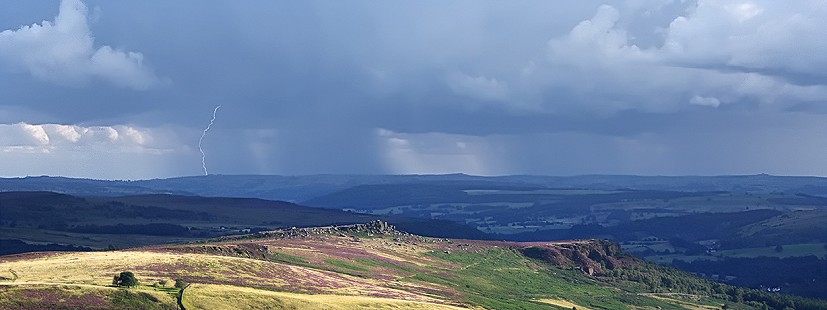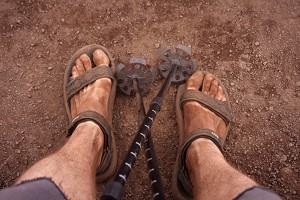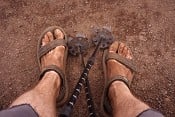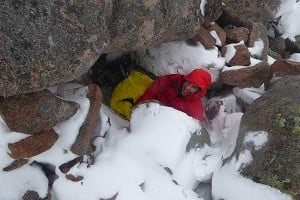
Humid weather has brought violent lightning storms across the country. You may associate it with bigger mountains and warmer climes, but lightning can also be a hazard in the British hills, and walkers are occasionally struck or even killed. Here's some timely advice on how to reduce the odds of getting hit by lightning when you're up high far from shelter.
It struck us as a bolt from the blue. One second we were sat on a ledge under the top block of The Cobbler sipping soup; the next we'd been fried. It was the loudest bang I've ever heard. We'd bounced in the air, though miraculously not off the edge of the crag. Ears ringing, we slumped in a daze.
My scrambled brain scrolled through the only two options it could think of: bomb or exploding soup? Jan soon sussed, and exhorted me to get moving before another lightning strike finished the job. It was easier yelled than done. My legs were numb; my hands buzzed so badly that I couldn't pick up my rucksack. Somehow we cringed through a hole in the rocks to safer ground and hot footed it away from the summit lightning rod, giggling manically.
In the corrie below we began to notice an odd smell, melting plastic and barbecued meat. Not keen to stop and investigate in case the feared barrage caught us in the open, we hurried on down. But no second strike came. Back at the car I peeled off layers of clothing, each holed with a little fag burn. Beneath I was branded with a target pattern of concentric rings. A smaller burn on my foot marked the exit, on through the sock and out of a hole in my boot.
Next stop A&E. We'd been lucky to survive, the doctors said, and equally fortunate to escape serious damage. Between 10-30% of lightning strikes are fatal, while up to 80% of survivors suffer long term injuries. The effects on the body range from external burns and hearing loss to muscle and nerve damage, seizures and cardiac arrest.
That day on The Cobbler we'd had no prior warning, no preceding thunder or visible storm clouds to chase us off. Thankfully the danger signs of imminent lightning are often more obvious. So how do you spot it coming, and what can you do to reduce your chances of getting struck if you're high up in the hills far from shelter?
Here's some advice from Mountain Training, reproduced from their skills handbook Hillwalking
- Lightning strikes rarely come as a 'bolt out of the blue'. Towering clouds build up as unstable air spirals upwards and condenses, giving a good warning to the observant walker.
- As a storm approaches, its location can be estimated by noting the difference in time between lightning flashes and the rumble of thunder. The light will appear almost instantly, while sound travels at a speed of 1km per 3 seconds. A six-second delay therefore means that the storm is about two kilometres away.
- Lightning strikes are quite frequent on summits and other projections such as pinnacles, because lightning takes the shortest route to earth. These are the areas of greatest risk, and at the first sign of an approaching lightning storm, the party should evacuate to a safer area.
- Scrambling terrain is particularly hazardous in lightning, and difficult to escape from quickly. A strike could easily knock somebody from his or her footing. Retreat should definitely not be by abseil, because the wet rope provides an excellent conductor. Steep or exposed ground should therefore be avoided if storms are forecast, or at least be pre-empted by a very early start and finish.
- Direct lightning strikes on people are relatively rare, but can be extremely violent and often fatal. More common is a partial strike, either through induction from an adjacent or nearby conductor, or through the ground as the earth currents dissipate outwards. The actual power of the strike is a combination of the current and the contact time.
- A projection such as a pinnacle or post acts as a lightning conductor that services an area with a radius corresponding approximately to its own height. This means that the surrounding ground within this circumference is a relatively safe place to wait because the projection will deflect lightning strikes onto itself (and anything touching it).
- Sheltering under an overhang or a tree is a hazardous course of action because a lightning strike will bridge the gap taking the most economical route, in this case through the people and into the ground. It is much safer to sit out in the open wearing waterproofs.
- A walking party sitting out a lightning storm should ideally crouch or sit upright on top of insulating material such as rucksacks and sleeping mats. Hands should be kept on knees rather than touching the ground.
- Metal items of equipment do not significantly increase the risk of attracting a strike, but if they start to hum and spark, it would be wise to accept the hint and lay them to one side until the storm passes.
And finally, as an illustration of the scary power of lightning check out this recent time-lapse sequence from Zion National Park in America:
More Articles



















Comments